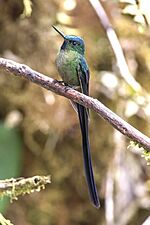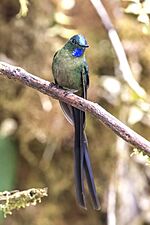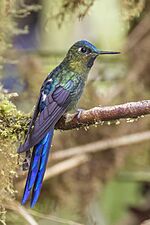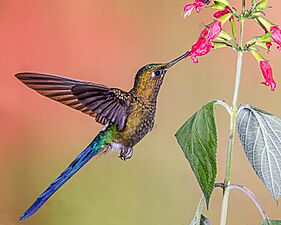Violet-tailed sylph facts for kids
Quick facts for kids Violet-tailed sylph |
|
|---|---|
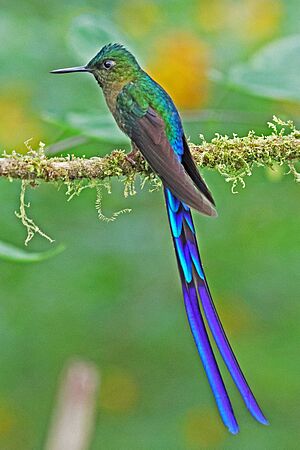 |
|
| male in NW Ecuador | |
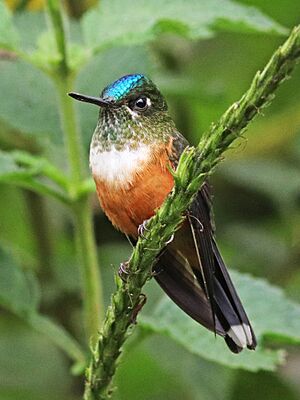 |
|
| female in NW Ecuador | |
| Conservation status | |
| Scientific classification | |
| Genus: |
Aglaiocercus
|
| Species: |
coelestis
|
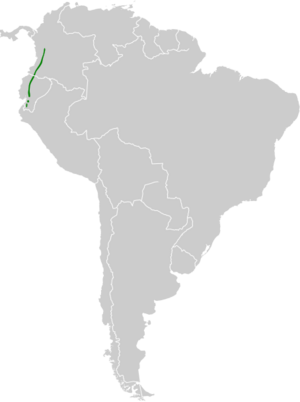 |
|
The violet-tailed sylph (Aglaiocercus coelestis) is a type of hummingbird. These tiny birds are known for their bright colors. They belong to a group called "coquettes." You can find them living in Colombia and Ecuador.
Contents
Meet the Violet-tailed Sylph: A Colorful Hummingbird
What is a Sylph?
The violet-tailed sylph is part of a bird family called Aglaiocercus. This group includes two other similar birds. They are the long-tailed sylph and the Venezuelan sylph. Scientists once thought these birds might be the same species. However, they now agree there are three separate species.
Different Types of Violet-tailed Sylphs
The violet-tailed sylph itself has two main types. These are called subspecies. They are named A. c. coelestis and A. c. aethereus. Each subspecies has slight differences in where they live or how they look.
What Does a Violet-tailed Sylph Look Like?
Male violet-tailed sylphs are quite long. They measure about 18 to 21 centimeters (7 to 8 inches). This length includes their very long outer tail feathers. These feathers can be 10 to 15 centimeters (4 to 6 inches) long! Females are much shorter, around 9.5 to 9.7 centimeters (3.7 to 3.8 inches). Both male and female birds weigh about 4.6 to 5.2 grams (0.16 to 0.18 ounces). That's lighter than a few paper clips! They all have a short, black beak.
Male Sylphs: Bright and Shiny
Males of the main subspecies, A. c. coelestis, are very colorful. Their head and back are a shining green. This color changes to violet-blue on their lower back. They have a light, creamy spot behind each eye. Their throat has a bright violet-blue patch. This patch is called a gorget. Their belly is green.
The male's tail is amazing. The inner feathers are short. But the outer feathers are super long. They are a shiny, metallic violet color. The tips of these long feathers are blue.
Female Sylphs: Pretty and Unique
Female A. c. coelestis birds also have a glittering blue head. They have a whitish spot behind their eyes. Their upper body colors are similar to the males. Their throat is white with green spots. A white band separates their throat from their belly. Their belly is a warm, reddish-brown color. Female tails are short and not forked. They are bluish-green with white tips on the outer feathers.
Young Sylphs and Subspecies Differences
Young violet-tailed sylphs look a bit duller. Their upper parts are dull green. Their underparts are a buffy green. They have light, creamy edges on their head feathers.
The other subspecies, A. c. aethereus, looks very similar. The main difference is that the male has a green throat patch. The female's throat has only a few light spots.
Where Do Violet-tailed Sylphs Live?
The main subspecies, A. c. coelestis, lives in Colombia and northern and central Ecuador. You can find them on the Pacific side of Colombia's Western Andes mountains.
The A. c. aethereus subspecies lives in southwestern Ecuador. They are found in the Andes mountains, between El Oro and Loja provinces.
Their Home: Cloudforests
These hummingbirds love to live in cloudforests. These are forests high in the mountains, often covered in clouds. They also live in areas where forests meet grasslands. This includes places with scattered trees and bushes. They are most common at about 1,000 meters (3,300 feet) high. But they can live as low as 300 meters (980 feet) and as high as 2,100 meters (6,900 feet).
How Violet-tailed Sylphs Behave
Moving Around
Violet-tailed sylphs usually stay in one area. However, they do move to different heights during the year. They follow where flowers are blooming. For example, in southwestern Colombia, they are common during the dry season. This is from January to April. But during the wet season, other types of sylphs might take their place.
What Do They Eat?
The violet-tailed sylph eats two main things: nectar from flowers and small insects. They often look for food close to the ground. But they will also fly up into the tops of trees.
They often use a method called trap-lining. This means they fly a regular path between many flowering plants. Male sylphs might also protect a specific area of flowers. They usually hover in front of flowers to drink nectar. But they can also cling to the flowers. They catch insects by flying out from a perch. This is called hawking. They also pick insects off plants.
Reproduction and Life Cycle
Violet-tailed sylphs usually breed between October and February. Both the male and female birds help build the nest. It's shaped like a dome. It's made of moss and spiderwebs. The nest has an opening on the side. They usually build it in a clump of moss or other plants growing on trees. These nests are also used for sleeping at night, even when it's not breeding season.
The female bird lays two white eggs. She sits on them for 15 to 17 days. This is called incubation. The young birds leave the nest when they are 26 to 30 days old.
Their Calls and Songs
The violet-tailed sylph has a special song. It sounds like a continuous series of short notes, "psit..psit..psit..". They also make different calls. One call is a repeated, short, buzzing sound. It sounds like "bzzt" or "bz-zzrt". They also make a higher-pitched, drawn-out "bzeee" sound. Another call is a high-pitched, twittering sound. It goes "seee..seee..seee..seee..tr-tr-tititi-teetsee..see..see."
Status: Are They Safe?
The IUCN (International Union for Conservation of Nature) has looked at the violet-tailed sylph. They have decided it is a species of "Least Concern." This means they are not currently in danger. They live in a large area. Even though we don't know exactly how many there are, their numbers seem to be steady. They are common in cloudforests. They also live in several protected areas. These birds can even live in areas changed by people, as long as some forest patches remain.



